from A newsletter for proactive planning... In this edition... How to claim the IHT transferable nil rate band Involuntary strike-off: what can you do? Capital allowances for cars Tax relief for bad debts Common deductible business expenses – don’t overlook claims Client Focus- Kingston Farmhouse August 2022 Issue www.compassaccountants.co.uk
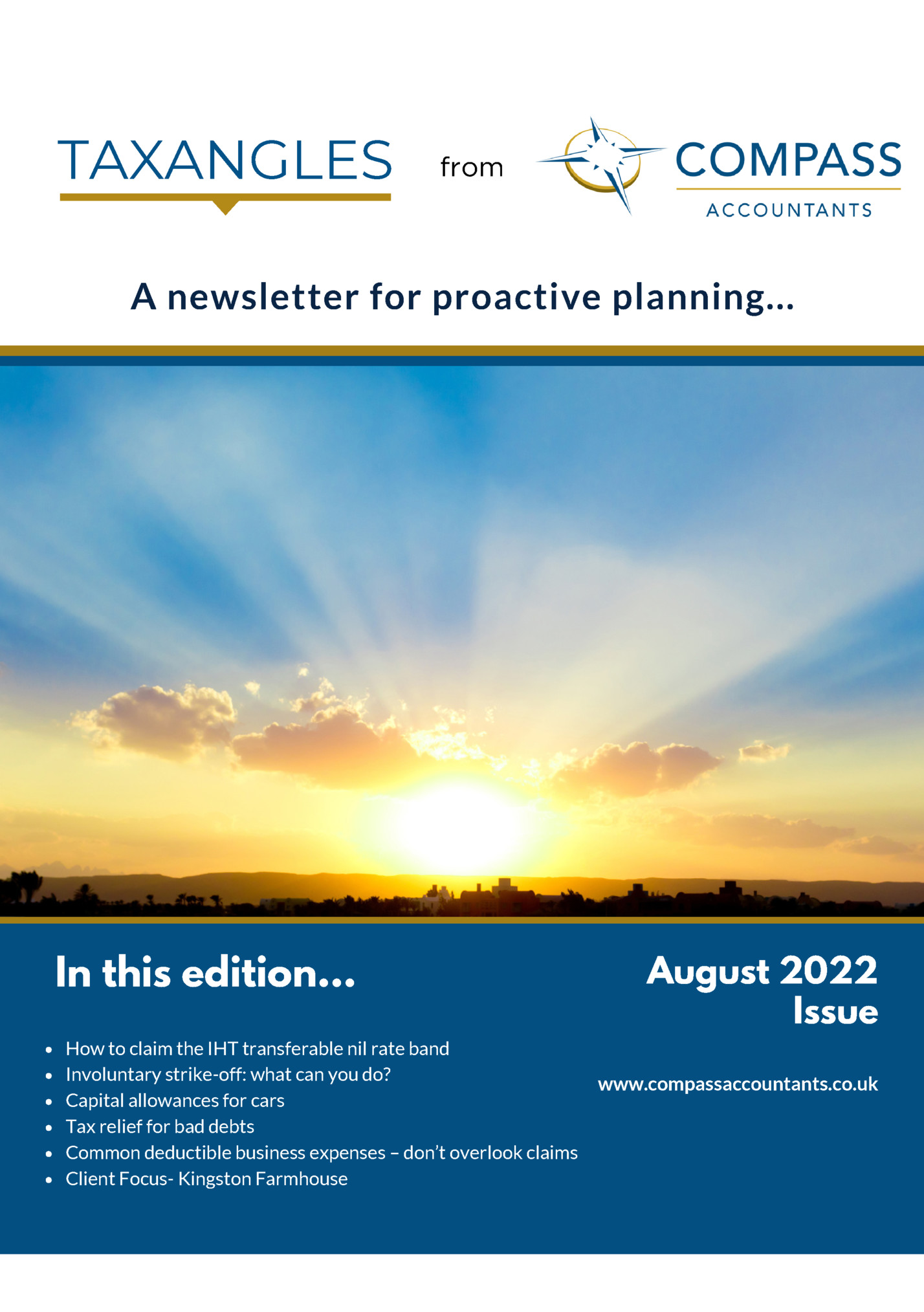
PAGE 2 How to claim the IHT transferable nil rate band For inheritance tax (IHT), there are potentially two nil rate bands available. The first – the nil rate band – is available to everyone and is set at £325,000 until 5 April 2026. An estate does not have to pay any IHT up to this amount. The second nil rate band is the residence nil rate band (RNRB). This is available where the main residence is left to a direct descendant, such as a child or grandchild. The RNRB is set at £175,000 until 5 April 2026. However, unlike the nil rate band, the RNRB is tapered where the value of the estate is more than £2 million. The RNRB is reduced by £1 for every £2 by which the value of the estate exceeds £2 million, meaning that it is not available to estates valued at £2.35 million and above. Spouses and civil partners An IHT inter-spouse exemption means that no IHT is payable on anything that a person leaves to their spouse or civil partner. Each spouse/civil partner has their own nil rate band and RNRB for IHT purposes. The IHT rules also allow any portion of the nil rate band or RNRB which is not used on the death of the first spouse/civil partner to be transferred to the surviving spouse/civil partner and claimed by their executors on their death. This is useful where a couple wish to leave their estate to their surviving spouse/civil partner in the first instance and to their children following the surviving spouse/civil partner’s death, but do not want to waste their nil rate bands. Transferring the nil rate band The percentage of the nil rate band that was not used when the first spouse/civil partner died can be used by the surviving spouse/civil partner’s estate as long as: ·the couple were married or in a civil partnership when the first death occurred; and ·the unused nil rate band is claimed within two years of the death of the surviving spouse or civil partner. It is important to note that it is the unused percentage of the nil rate band that is transferred, not the absolute amount. This provides an automatic adjustment if the nil rate band changes between the first death and the second death. The way in which the claim is made depends on whether a full IHT return (IHT400) is needed. If a full return is required, the claim should be made on form IHT402, which should be sent to HMRC with the IHT400 (and any other forms that are required). The IHT400 should be sent to HMRC within 12 months of the date of death. If the death occurred after 1 January 2022 and the estate is an excepted estate, the transferable nil rate band can be claimed when applying for probate. Transferring the unused RNRB As with the nil rate band, the unused percentage of the RNRB is available on the estate of the surviving spouse or civil partner. Again, this must be claimed. This is done on form IHT435 which should be sent to HMRC with the IHT400. Example Polly died in June 2017 leaving her estate valued at £600,000 to her husband Paul. At the time of her death, the nil rate band was £325,000 and the RNRB was £100,000. CONTINUED ON PAGE 3

PAGE 3 Paul dies in May 2022. He leaves his entire estate, valued at £1.4 million to his daughter Poppy. In addition to his nil rate band of £325,000 and his residence nil rate band of £175,000 his estate is able to claim the unused portion of Polly’s nil rate band and RNRB, which is 100% in each case. Consequently, Paul’s estate is able to benefit from a further nil rate band of £325,000 and a further residence nil rate band of £175,000. As it is the unused percentage that is transferred, Paul’s estate benefits from 100% of the RNRB at its value of the time of his death (i.e. £175,000), rather than the absolute value of the RNRB at the time of Polly’s death (i.e. £100,000). Consequently, IHT is only payable to the extent that the value of his estate exceeds £1m (2x £325,000 + 2 x £175,000). Involuntary strike-off: what can you do? Object The registrar of companies has the power to strike a company off a register if the registrar has reasonable cause to believe that the company is no longer carrying on a business or is in operation. This may be the case if the company has failed to file its annual accounts or its annual confirmation statement, there is no director in place or mail sent to the company is returned unopened. However, before the registrar can move to strike the company off, he or she must first send two letters to the company. If a response is not received from the company within one month of sending the first letter, the registrar must (within 14 days of the end of the expiration of that month) send a second letter by registered post. The second letter must refer to the first letter and state that an answer to that letter has not been received and also that if an answer is not received to the second letter within one month of the date on the letter, a notice will be placed in the Gazette with a view to striking the company’s name off the registrar. If letters are received, they should not be ignored; rather, they should be dealt with promptly. In the event that no answer is received to the second letter within a month of the date of that letter and the registrar has not received evidence that the company remains in business, the registrar will place a first notice In the Gazette that unless evidence is received to show that the business is still in operation, it will be struck off the register two months after the date of the notice. An objection to the proposed striking off can be made after the notice has been placed in the Gazette. An objection can be made by a director or a shareholder, or another interested party, such as a supplier or a customer. The objection can be made by email (enquiries@companieshouse.gov.uk). When making an objection, it is necessary to provide evidence that the company is still trading, is owed money or owes money. The evidence may be in the form of customer or supplier invoices or statements or company bank statements. If the striking off application has been made because the company has failed to file its accounts or its confirmation statement, the outstanding documents should also be filed. The objection must be made at least two weeks before the expiry of the Gazette notice (which is two months from the date of publication of the notice). If the objection is successful, the registrar will discontinue the strike and file form DISS40, Striking off action discontinued. Company struck off If no objection is made by the expiry of the first notice, a second notice will be posted in the Gazette, stating that the company has been struck off. It will be dissolved on the publication of this notice.
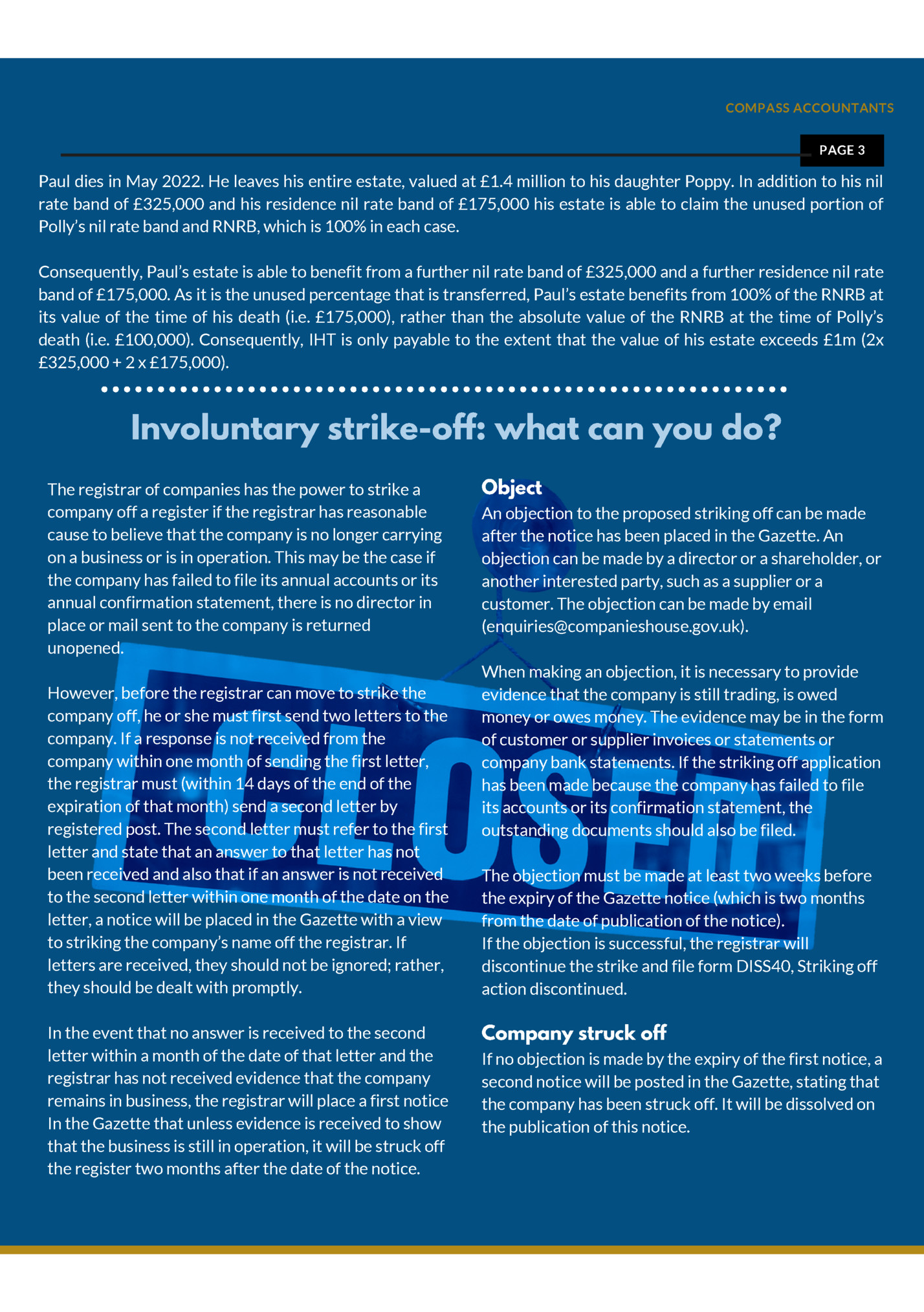
PAGE 4 Capital allowances are a mechanism for providing tax relief for capital expenditure. Relief is generally given in the form of a writing down allowance, although a first year allowance is available for expenditure on new and unused zero-emission cars. Expenditure on cars does not qualify for the annual investment allowance or for the timelimited super-deduction or 50% first-year allowance available to companies. Capital allowances cannot be claimed where the simplified expenses system is used to pay mileage allowances. Capital allowances for cars can be claimed by both unincorporated businesses and companies. They can also be claimed where the cash basis is used as expenditure on cars cannot be deducted under the cash basis capital expenditure rules. First-year allowance A 100% first-year allowance is available for expenditure on new and unused zero-emission cars. This means that the cost can be deducted in full in computing taxable profits in the period in which the expenditure is incurred. The first-year allowance is only available for new cars; second-hand zero-emission cars only qualify for a writing down allowance. A balancing charge, equal to the sale proceeds, will arise if the car is sold. Writing down allowances There are two rates of writing down allowance – the main rate and the special rate. The available rate depends on the car’s CO2 emissions and the date on which the expenditure was incurred. New and used cars purchased on or after 6 April 2021 which have CO2 emissions of 50g/km or less (other than new electric cars qualifying for a 100% first-year allowance) are added to the main rate pool and receive main rate allowances at the rate of 18% on a reducing balance basis. Cars purchased on or after 6 April 2021 with CO2 emissions in excess of 50g/km must be added to the special rate pool. They attract special rate writing down allowances of 6% on a reducing balance basis. If the car is sold, the sale proceeds must be added to the relevant pool. This ensures that capital allowances are given for the difference between the cost and the proceeds over the life of the car. Private use If a sole trader or partner uses a car partly for business and partly for private use, capital allowances are proportionately reduced to reflect the private use. Cars used for business and private use have their own pool rather than being added to the main rate or special rate pool. Employees Employees are not able to claim capital allowances for cars, even if they use them for business. The approved mileage rates (which may be paid tax-free up to the approved amount) provide an element to cover depreciation.

PAGE 5 Tax relief for bad debts Bad debts are a fact of business life and most businesses will suffer a bad debt from time to time. This may be because the customer goes out of business after the work has been done or the goods have been supplied, or runs into financial difficulty resulting in them defaulting on the debt. Unfortunately, sometimes the customer may just not pay and refuse all attempts to recover it. While there are actions that the business can take to recover the debt (such as making a claim using the Money Claim Online service), there is no guarantee that these will work, and the business may simply have to accept that the debt has gone bad. Having suffered a bad debt, it would be adding insult to injury if the business had to pay tax on income that had not actually received. Fortunately, the tax system offers some relief for bad debts. The way in which relief is given depends on whether the accounts are prepared under the cash basis or the accruals basis. Cash basis One of the advantages of the cash basis is that it provides automatic relief for bad debts. Under the cash basis, income is not recognised until it is received, so if an invoice is not paid, it is not taken into account when calculating taxable profits. Consequently, there is no need for special rules to deal with bad debts. Traders with cash basis receipts of £150,000 or less can elect to use the cash basis. It is the default basis for landlords with rental cash basis receipts of £150,000 or less, and landlords not wishing to use the cash basis must elect for the accruals basis to apply. Companies cannot use the cash basis to prepare their accounts. Accruals basis Under the accruals basis, income must be recognised when earned. This means that if work is undertaken, the associated income is taken into account when the work is done not when the invoice is paid. Consequently, the invoiced amount will be reflected in the calculation of taxable profit, regardless of whether it has been paid. The amount owing will show in the balance sheet as a debtor of the business. Normally, a deduction is not allowed for a debt owed to a business in computing the taxable profit. However, an exception is made for a bad debt and for a doubtful debt to the extent that it is estimated to be bad. This will be the total amount of the debt less any amount that the business may reasonably expect to receive. Where a debt is bad or doubtful, a deduction can be made in the period in which the debt became bad or doubtful. This may not necessarily be the same period as when the income is taxed if at that point it was expected that the debt would be paid. Example ABC Ltd prepares accounts to 31 March each year. As a company, it prepares accounts using the accruals basis. CONTINUED ON PAGE 6
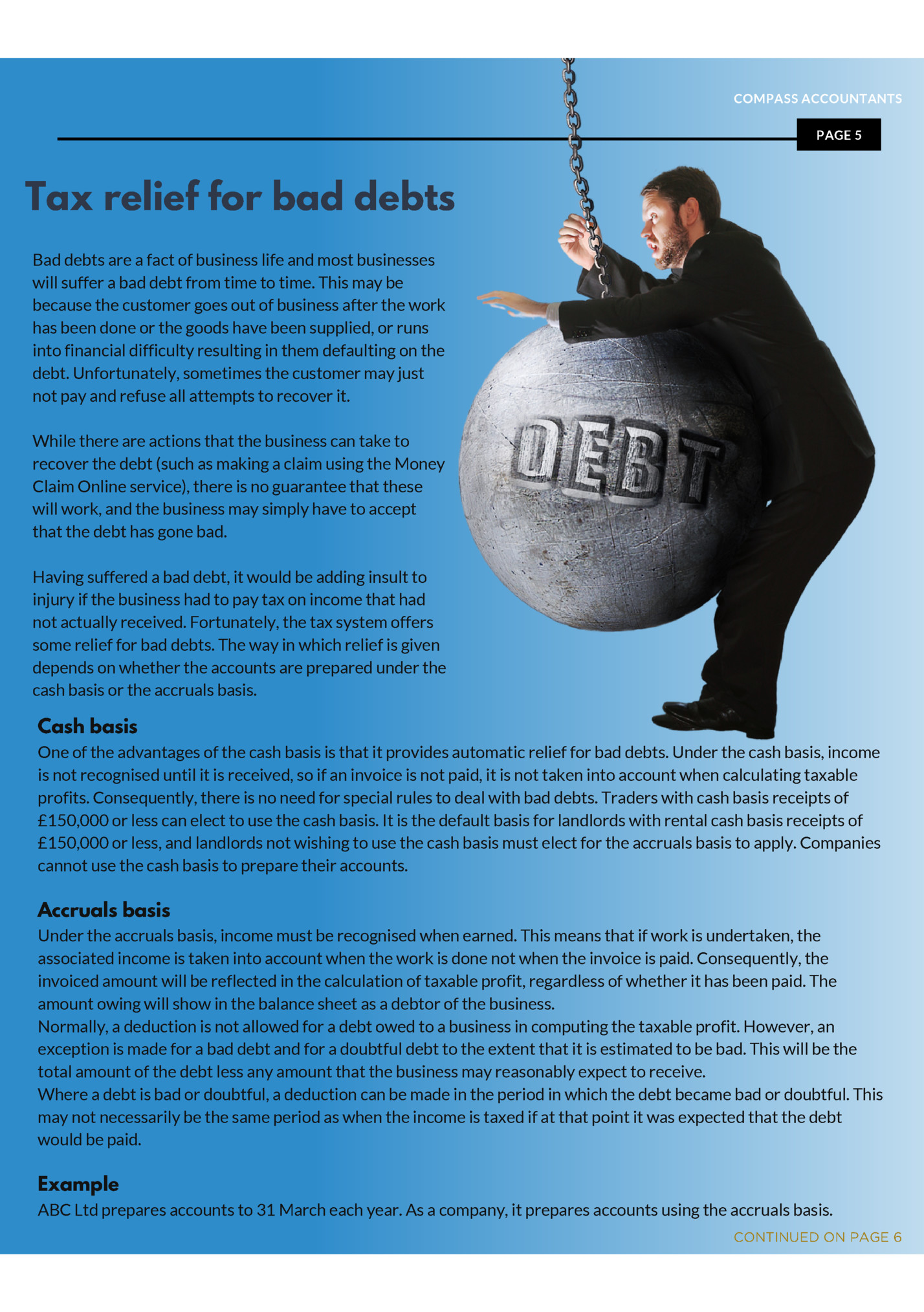
PAGE 6 On 21 March 2022 it invoices a customer for £3,000. The invoice is taken into account in calculating the taxable profit for the year to 31 March 2022. In July 2022, the customer went into liquidation without paying the debt. Recovery looks very unlikely. Tax relief is given in the form of a deduction of £3,000 when calculating the profit for the year to 31 March 2023 as this is the period in which the debt went bad. Common deductible business expenses No-one wants to pay more tax than they need to. Consequently, it is important to keep good records of business expenses so that deductible expenses are not overlooked. General rule The basic rule is that a deduction is allowed for expenses incurred wholly and exclusively for the purpose of the trade, profession or vocation. Unlike the equivalent rule for employment expenses, there is no requirement that the expense is ‘necessarily’ incurred. This means that as long as an expense is incurred for the purposes of the business and only for that purpose, a deduction is given. Private expenses are not deductible No deduction is given for private expenditure and under no circumstances should private items be `put through the business’. It is good practice to keep private and business expenditure separate and to have a separate bank account for business expenses. If you run your business as a limited company, the company should have its own bank account. Mixed use expenses If you incur an expense for both business and private purposes, you can deduct the private element if this can be separately identified. This may be the case if you use a phone for business and private calls.
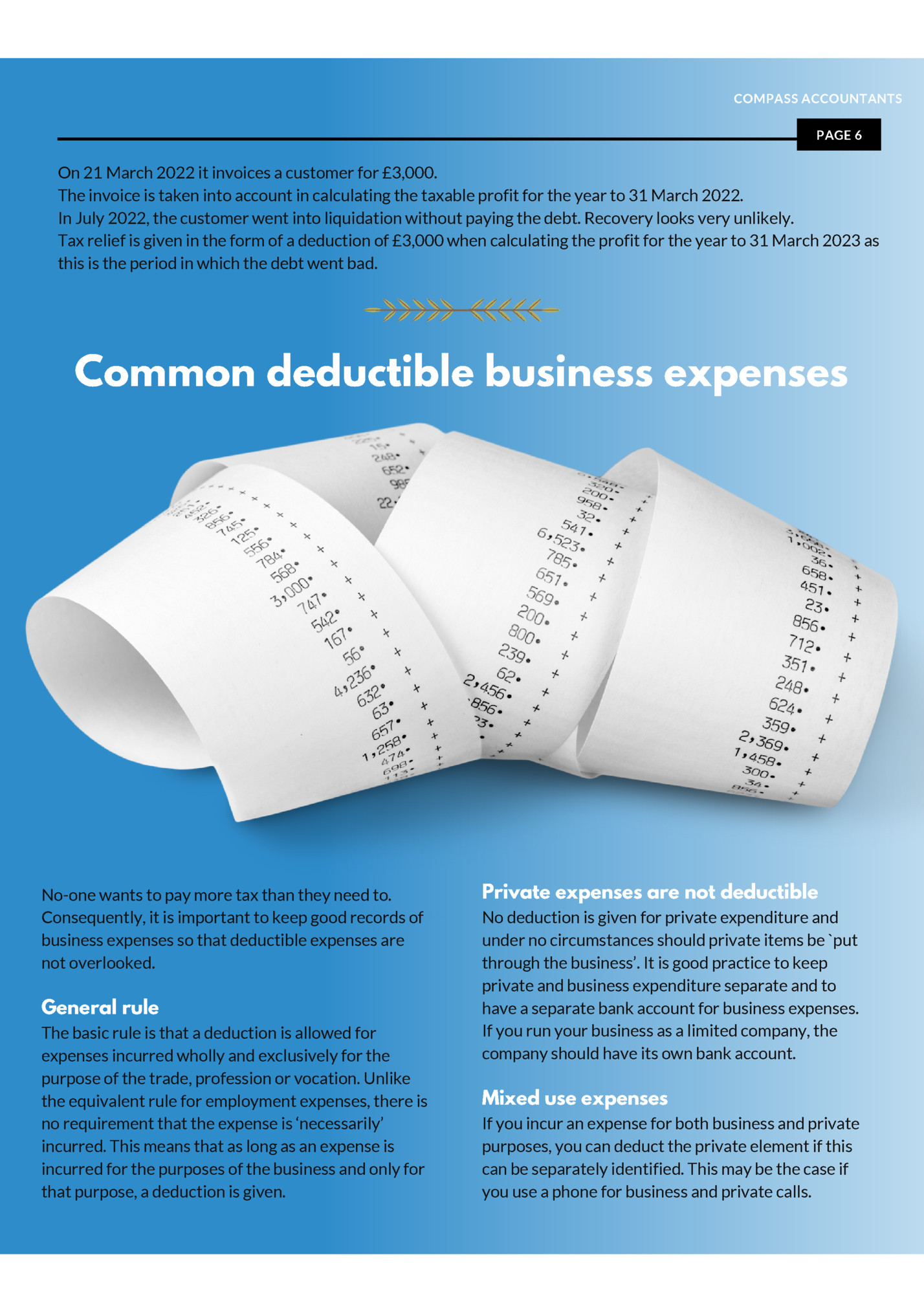
PAGE 7 Any apportionment should be on a just and reasonable basis. If you cannot separate out the private use and the expense has a dual purposes (such as work clothes which also provide warmth and decency), the expense should not be deducted. No deduction for drawings If you operate your business as a sole trader or other unincorporated business and you pay yourself a salary or take drawings from the business, you cannot deduct these when working out your profit. You pay tax on your profit and are free to use the profits as you please. However, if you operate as a personal or family company, you can deduct any salary that you pay yourself (together with any employer’s National Insurance and employer pension contributions). Capital expenditure Capital expenditure can only be deducted in computing profits if you use the cash basis and the expenditure can be deducted under the cash basis capital expenditure rules. You cannot deduct capital expenditure if you prepare accounts under the accruals basis. Common deductible expenses The actual expenses that can be deducted will vary from business to business – what is important is that they are incurred wholly and exclusively for the purpose of the business. However, the following are example of common deductible business expenses. 1. Cost of goods sold, such as raw materials and goods brought for resale. 2. Distribution and packaging costs. 3. Office expenses, such as stationery and printing costs and phone bills. 4. Travel and subsistence expenses, such as fuel parking and fares for using public transport and hotel bills for overnight business trips. 5. Motor expenses, such as car insurance, MOTs and repairs. 6. Staff costs, such as wages, salaries, employer’s National Insurance and pension costs. 7. Rent and rates. 8. Gas, electricity and water bills. 9. Repairs 10. Advertising and promotion costs. 11. Bank interest and other finance costs. 12. Accountancy, legal and other professional costs. 13. Uniforms (but not general clothing even if only worn for work). Non-deductible expenses A deduction for certain expenses is expressly prohibited. This includes the cost of business entertaining, which if deducted in computing accounting profit must be added back to arrive at taxable profit. Likewise, depreciation (an accounting concept) is not deductible in arriving at taxable profit; instead relief is given in the form of capital allowances.
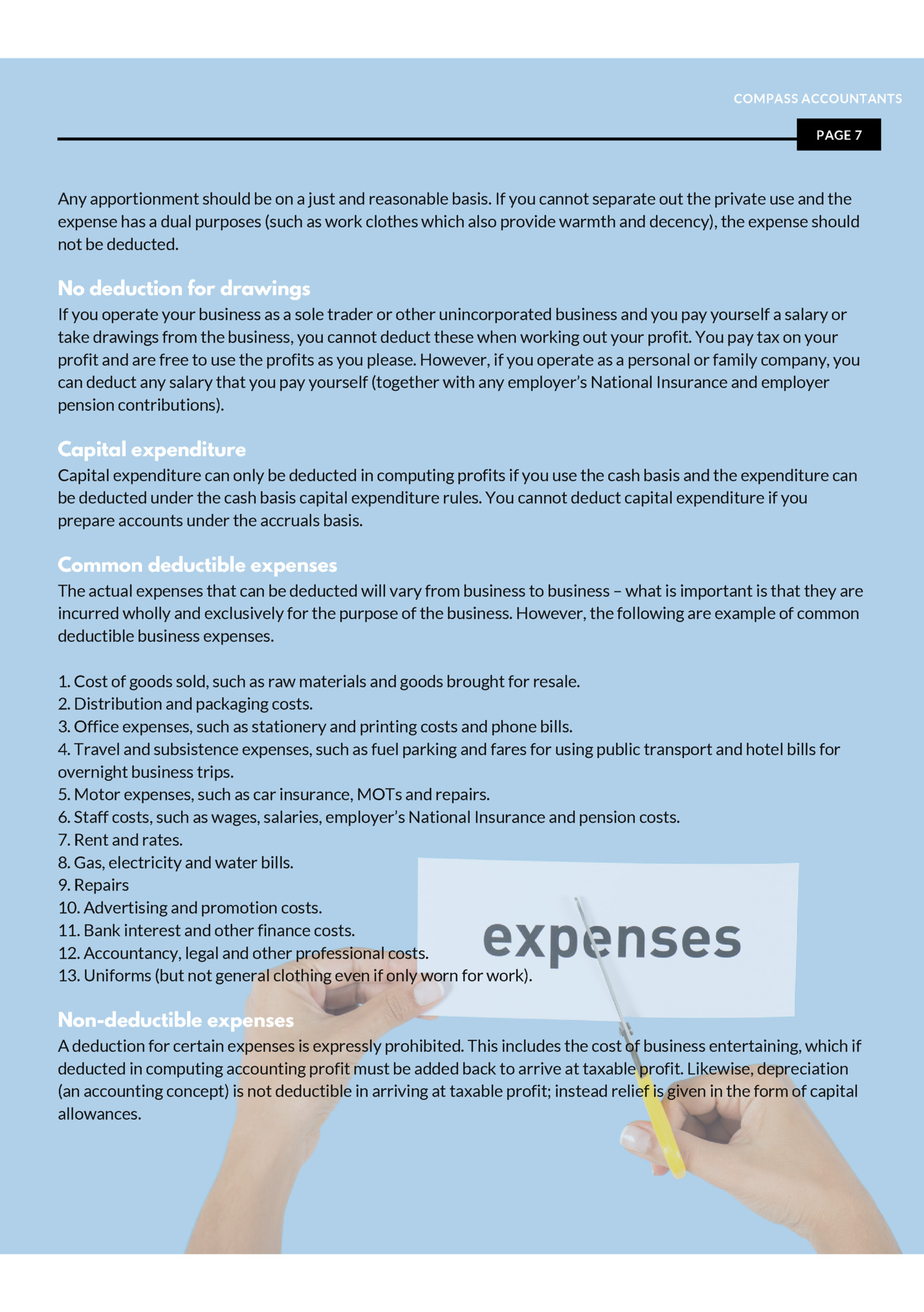
PAGE 8 Client Focus- Kingston Farmhouse In this Client Focus, we chat to Compass Client, Donna Blight, the Co Owner of Kingston Farmhouse on the Isle of Wight … Kingston Farmhouse was built in 1864, as a part of Queen Victoria’s Osborne Estate on the Isle of Wight. Originally, the house was built to serve as a dairy for Osbourne House, where Queen Victoria would often spend her summers. This beautiful Victorian building, with five double bedrooms is situated on a quiet private road in East Cowes, where the co-owner of the house, Donna Blight, had the pleasure of growing up. “I’ve always loved the house,” explains Donna, “and so it was a great pleasure to build a rental business around it, bringing all the old features back to how they were when I was young.” Until December last year, Kingston Farmhouse was a care home that supported adults with learning disabilities. It was only at the end of 2021, that Donna and Jenny made the decision to redesign the building, bringing it back to how it was when it was their home, and renting it out to holiday makers and tourists on the island. “After 25 years of running a care home, we were ready for a change,” said Donna, “and as the legislation aspect of running the home grew more and more complicated and time consuming, we decided, now was a good time to do it. Also- it was a perfect time for change for our clients, as they were all in a good place and were all ready to move.” Before the care home business ended, Donna and her mum put a business plan together, and finally closed the doors on New Year’s Eve 2021. They started work on January 10th, 2022 – and Kingston Farmhouse was open and ready to rent by June 10th, 2022. “It was a busy time, but we completely stripped the building and made it like it was when I was a child -but betterpreserving, developing and enhancing all the original Victorian features.” Since launching the business in June, Donna and Jenny have already had a great response from people looking to rent the property. “June was fantastic” said Jenny, “Because we are in such a wonderful location, people were immediately booking the house. Plus, this part of the island is really up and coming and Osbourne House is only a 10-minute walk away, which is a wonderful place to visit. There is also access to the beach from Osborne House now too, following the developments the English Heritage made five years ago. We are hopefully going to experience a very busy summer!” As two Islanders, Donna and Jenny do their best to source everything locally, and even work with a new Island agency to promote the rental of the property, The Island Holiday Company. Now, the unique property can be booked in its entirety if guests require all the rooms, accommodating up to 10 people. There is also a one bedroomed building attached to the CONTINUED ON PAGE 9 CONTINUED ON PAGE 9
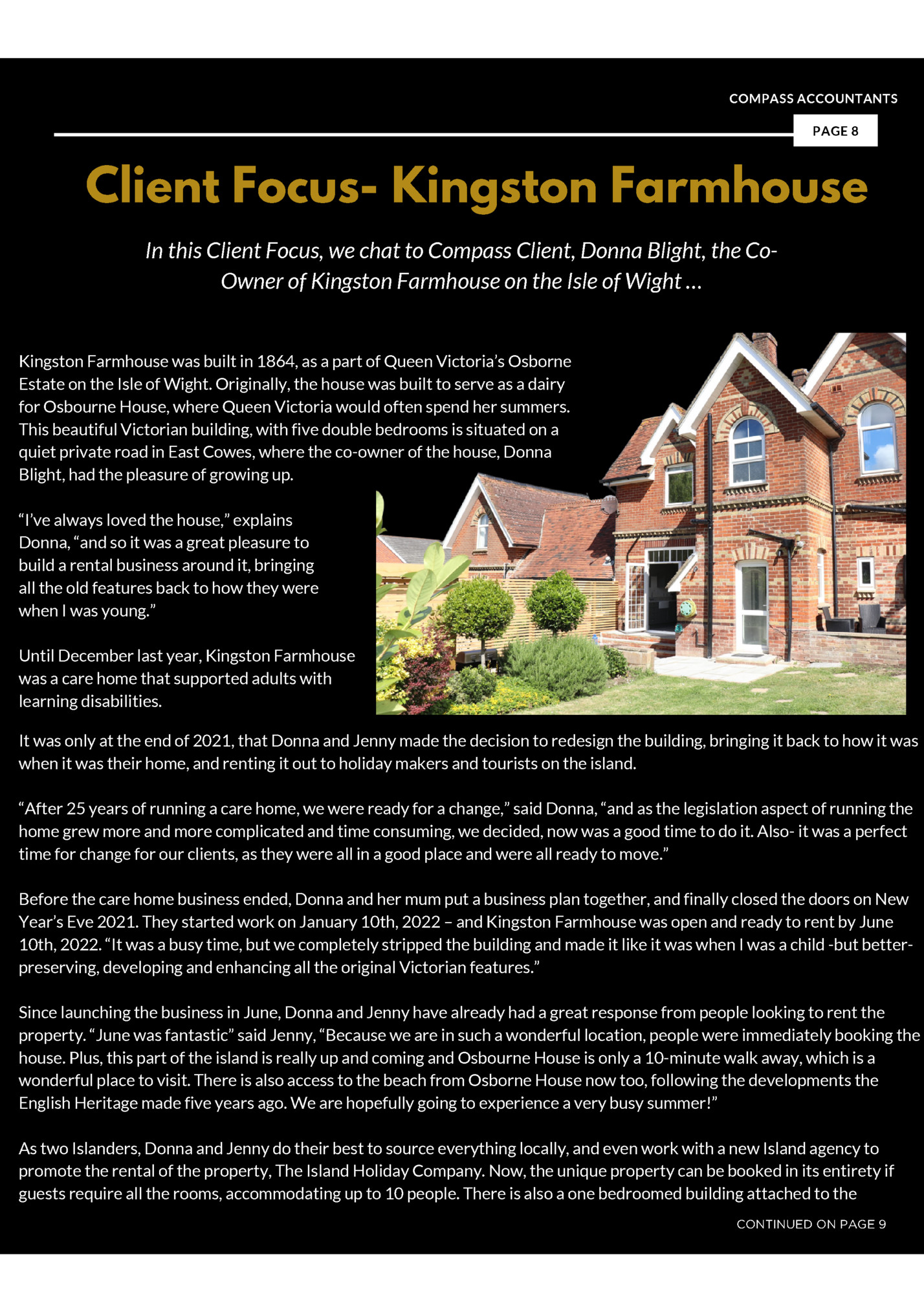
PAGE 9 farmhouse called ‘The Creamery’ where the dairy once was- meaning the whole estate can actually accommodate up to 12 people at once, making it the largest rentable building in East Cowes. Working alongside Compass Having been a client during the time that Kingston Farm was a care home, Donna and Jenny have already experienced many years of working with Compass, and so they were sure they wanted them on board for the new business. “We have had over 15 years of working with Compass, and have always appreciated their support and guidance, so we knew from the start that they would be the perfect accountants to help us with a new business.” Said Donna. “And we were right, they’ve been amazing. They have steered us through the launch of this new venture and as always, it’s been great to have them on board. It’s so important to have an accountant with all the right skills, but it’s also important that you have a good working relationship with them. Stuart has been brilliant and acted as our key person for around 15 years now, so he knows us very well.” “We feel very fortunate to have an accountant you can just openly chat to. If you need to speak to someone, you just pick up the phone and they are thereand if they aren’t, they always get back to you. They have great knowledge and skills, and experience, but they are also committed to learning and keeping up with new developments, and they pass that growing knowledge on to their customers – which is so important.” Donna is currently offering Compass' clients a reader deal on September bookings- please contact her directly to find out more on 07798700675. To see more images of the property, follow their Instagram page on @kingston_farmhouse or @the_creamery1 CONTINUED ON PAGE 9
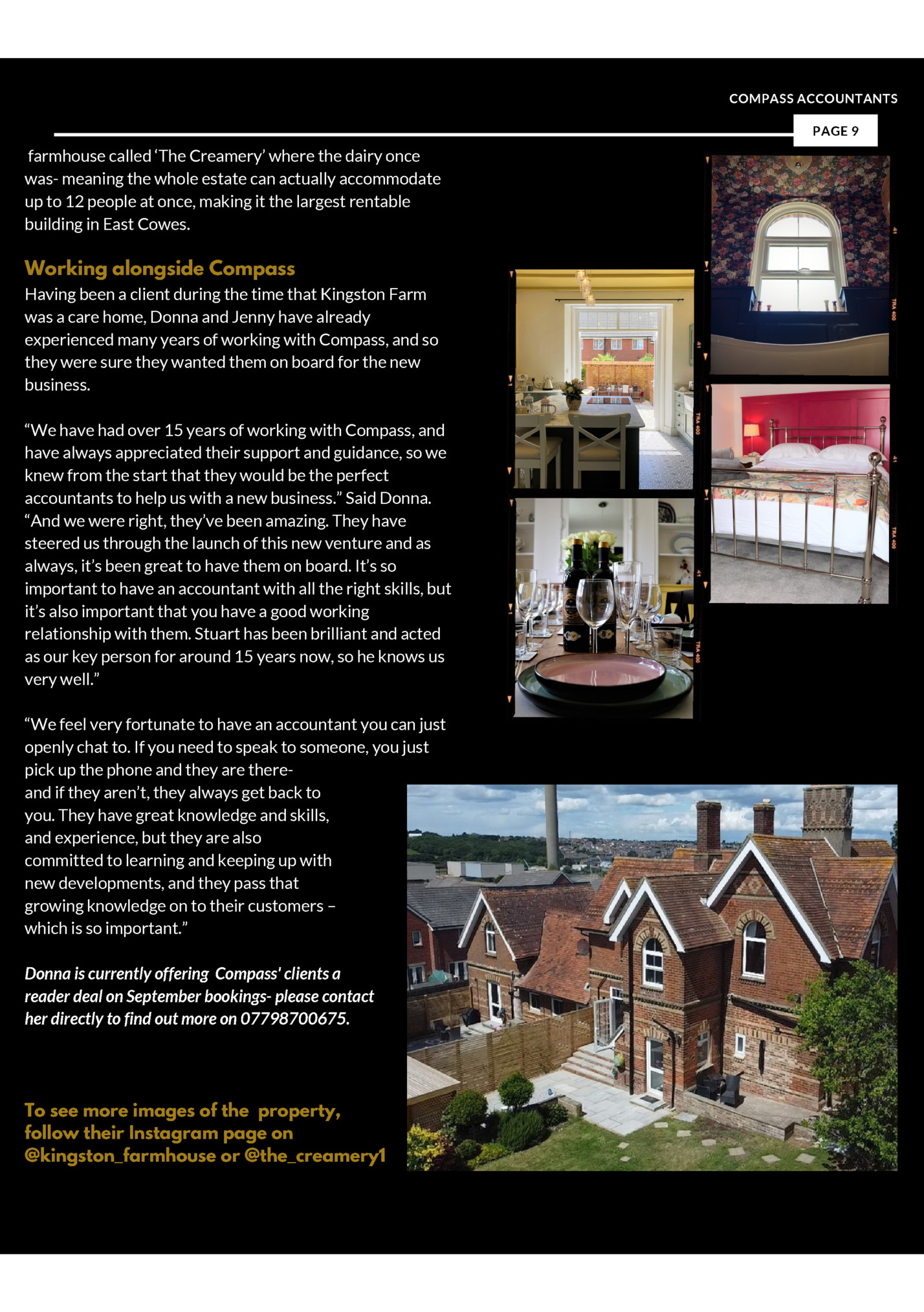
Fleepit Digital © 2021